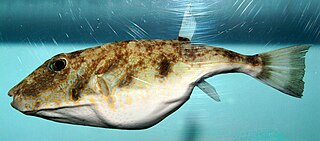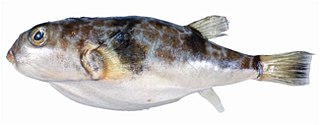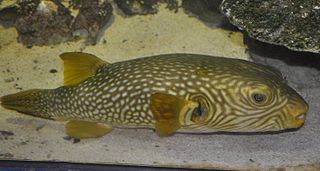
Tetraodontidae is a family of primarily marine and estuarine fish of the order Tetraodontiformes. The family includes many familiar species variously called pufferfish, puffers, balloonfish, blowfish, blowers, blowies, bubblefish, globefish, swellfish, toadfish, toadies, toadle, honey toads, sugar toads, and sea squab. They are morphologically similar to the closely related porcupinefish, which have large external spines.

Tetraodontiformes, also known as the Plectognathi, is an order of ray-finned fishes which includes the pufferfishes and related taxa. This order has been classified as a suborder of the order Perciformes, although recent studies have found that it, as the Tetraodontoidei, is a sister taxon to the anglerfish order Lophiiformes, called Lophiodei, and have placed both taxa within the Acanthuriformes. The Tetraodontiformes are represented by 10 extant families and at around 430 species overall. The majority of the species within this order are marine but a few may be found in freshwater. They are found throughout the world.

The narrow-lined pufferfish or striped puffer is a demersal marine fish belonging to the family Tetraodontidae.

Sphoeroides is a genus of pufferfishes.

Valentin's sharpnose puffer, also known as the saddled puffer or black saddled toby, is a demersal marine fish belonging to the family Tetraodontidae. The saddled puffer is a small sized fish which grows up to 11 cm. It is widely distributed throughout the tropical and subtropical waters of the Indian Ocean, Red Sea included, and until the oceanic islands of the Pacific Ocean. It inhabits rocky and coral reefs, lagoons and external reef until 55 m. Canthigaster valentini has a diurnal activity.

The map puffer, also known as the map pufferfish, scribbled pufferfish, or Kesho-fugu, is a demersal marine fish belonging to the family Tetraodontidae. The map puffer is typically found in tropical and subtropical waters from the Indian Ocean to the western Pacific Ocean. This fish contains tetrodotoxin, a potent and deadly chemical compound used to ward off predators. Despite being highly poisonous, the map puffer can be found both in the aquarium trade and certain food markets.

Reicheltia halsteadi, Halstead's toadfish, is a species of pufferfish endemic to Australia. This species grows to a length of 16 centimetres (6.3 in) TL. This species is the only known member of the genus Reicheltia.

The bandtail puffer is a species in the family Tetraodontidae, or pufferfishes. It can grow to a length of about 30 cm and is common in the Caribbean and observed from Massachusetts, USA in the north to Santa Catarina, Brazil in the south.

The checkered puffer is a species in the family Tetraodontidae, or pufferfishes.

Least puffer is a species in the family Tetraodontidae, or pufferfishes. This species is the common bay and inshore puffer for the waters around Texas and Louisiana. It has also been found as far east as Apalachicola Bay and south to Yucatán. Mature least puffers are small, usually less than four inches (100 mm).

The northern puffer, Sphoeroides maculatus, is a species in the family Tetraodontidae, or pufferfishes, found along the Atlantic coast of North America. Unlike many other pufferfish species, the flesh of the northern puffer is not poisonous, although its viscera can contain poison, and high concentrations of toxins have been observed in the skin of Floridian populations. They are commonly called sugar toads in the Chesapeake Bay region, where they are eaten as a delicacy. There was widespread consumption of northern puffers during the rationing that accompanied the Second World War, establishing a commercial fishery that reached its zenith in the 1960s. In much of the Northeast, the fish is known simply as "blowfish" or "chicken of the sea". They may also be sold as "sea squab".

Canthigaster rostrata, commonly known as the Caribbean sharp-nose puffer, is a pufferfish from the Western Central Atlantic. The Caribbean sharp-nose puffer is a small fish with a maximum length of 12 cm or approximately 4.7 inches. It can be encountered from the coast of South Carolina to Venezuela, including Bermuda, the Gulf of Mexico, and in the Caribbean Sea. They can live up to 10 years in the wild, females typically live longer due to aggressive male territory behavior. The Caribbean sharp-nose puffer is a highly toxic species of marine fish due to the presence of tetrodotoxin in its tissues and organs. Despite its toxicity, the sharp-nose pufferfish occasionally makes its way into the aquarium trade.

Arothron meleagris, commonly known as the guineafowl puffer or golden puffer, is a pufferfish from the Indo-Pacific, and Eastern Pacific. It is occasionally harvested for the aquarium trade. It reaches 50 cm in length.

Arothron immaculatus, the immaculate puffer or yellow-eyed puffer, is a pale greyish to brownish pufferfish from the Indo-West Pacific. It is a species of marine fish in the family Tetraodontidae.

Arothron stellatus, also known as the stellate pufferfish, starry puffer, or starry toadfish, is a demersal marine fish belonging to the family Tetraodontidae. It is found in shallow water in the Indo-Pacific region.

Sphoeroides annulatus is a species in the family Tetraodontidae, or pufferfishes. It is found in the eastern Pacific Ocean from California, USA to Pisco, Peru and the Galápagos Islands.
Canthigaster tyleri, also known as Tyler's toby, is a species of marine fish in the family Tetraodontidae.

Arothron reticularis, variously known as the reticulated pufferfish, reticulated blowfish or reticulated toadfish, is a ray-finned fish in the family Tetraodontidae. It is native to the tropical and sub-tropical Indo-Pacific region where its habitats include sandy and muddy seabeds, coral reefs, estuaries and mangrove areas.

Canthigaster jamestyleri, known as the goldface toby, is a species of marine fish in the family Tetraodontidae. It was first isolated from the southeast coast of the US, in the Atlantic Ocean.
Canthigaster figueiredoi, known as the Southern Atlantic sharpnose-puffer, is a species of marine fish in the family Tetraodontidae. It was first isolated from the east coast of South America, in the Atlantic Ocean.


















